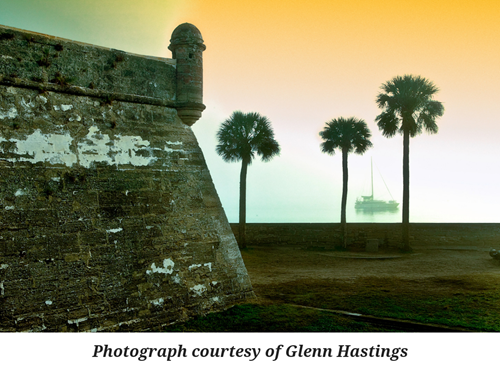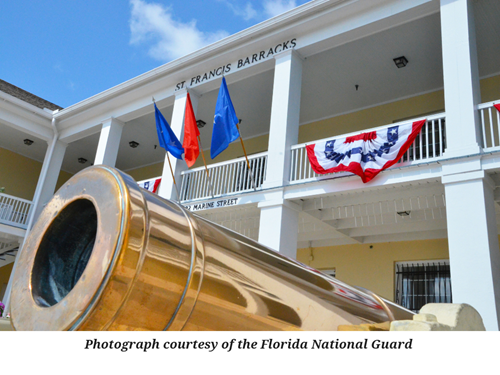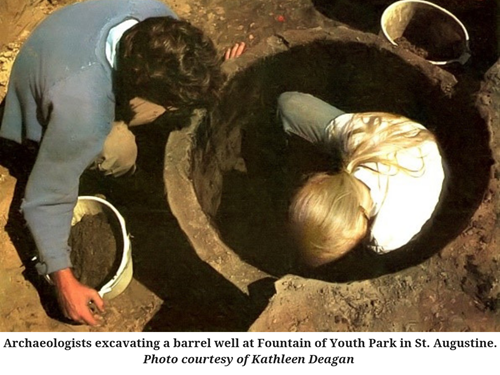St. Augustine
Founded in 1565, St. Augustine is the longest continuously occupied European settlement in North America. As the military, administrative, and religious headquarters of Spanish Florida in the Colonial Period, it was the site of many international battles for control of the Southeast. The establishment of Charleston by the English in 1670 prompted Spain to construct the impressive Castillo de San Marcos to protect the capital of La Florida.
 There was no mission inside the town of St. Augustine, as all of the missions were established in native villages for the purpose of converting their inhabitants to Christianity. So, by the time the formal Camino Real was established in the 1680s, most Indians and soldiers travelling to St. Augustine were headed for the Castillo, where the native barracks was located and supplies were delivered and stored. Friars and Indian chiefs arriving to St. Augustine on the Camino Real probably went on to the Franciscan headquarters at the Convento de San Francisco (located at today’s St. Francis Barracks). But wherever their final destination was, all travelers probably entered town at the north end of what is now St. George Street, where the City Gates would eventually be built.
There was no mission inside the town of St. Augustine, as all of the missions were established in native villages for the purpose of converting their inhabitants to Christianity. So, by the time the formal Camino Real was established in the 1680s, most Indians and soldiers travelling to St. Augustine were headed for the Castillo, where the native barracks was located and supplies were delivered and stored. Friars and Indian chiefs arriving to St. Augustine on the Camino Real probably went on to the Franciscan headquarters at the Convento de San Francisco (located at today’s St. Francis Barracks). But wherever their final destination was, all travelers probably entered town at the north end of what is now St. George Street, where the City Gates would eventually be built.
The Convento de San Francisco was St. Augustine’s original Franciscan church and friary. Built in 1588, it served as a training center for new friars coming to Spanish Florida and the headquarters for missionaries in the field. The Convento also offered an infirmary to care for sick and elderly members of the Franciscan Order. The early wooden structures did not survive a 1599 fire that destroyed most of St. Augustine. It was rebuilt by 1604, but destroyed again during the 1702 Siege of St. Augustine by English forces from Carolina.
 In the 1750s, new coquina structures replaced the older wooden buildings, but the complex was soon turned over to British control, when Spain ceded Florida to England in 1763. After that time, the former Franciscan headquarters was remodeled, converted to military use, and renamed St. Francis Barracks. Today, the property is home to the Florida National Guard.
In the 1750s, new coquina structures replaced the older wooden buildings, but the complex was soon turned over to British control, when Spain ceded Florida to England in 1763. After that time, the former Franciscan headquarters was remodeled, converted to military use, and renamed St. Francis Barracks. Today, the property is home to the Florida National Guard.
St. Augustine Today
 Visitors to St. Augustine enjoy its Old World charm and historic ambiance. There are still a number of First Spanish Period (1565-1763) landmarks to see, including the magnificent Castillo de San Marcos, St. George Street, Government House, the town plaza, and St. Francis Barracks. It is not uncommon to find archaeologists working near homes or in courtyards, or at sites such as the Fountain of Youth Park or the Ximenez-Fatio House. St. Augustine is an area of national importance that underscores how history and archaeology benefit a local economy, and why historic preservation is essential to understanding our collective heritage.
Visitors to St. Augustine enjoy its Old World charm and historic ambiance. There are still a number of First Spanish Period (1565-1763) landmarks to see, including the magnificent Castillo de San Marcos, St. George Street, Government House, the town plaza, and St. Francis Barracks. It is not uncommon to find archaeologists working near homes or in courtyards, or at sites such as the Fountain of Youth Park or the Ximenez-Fatio House. St. Augustine is an area of national importance that underscores how history and archaeology benefit a local economy, and why historic preservation is essential to understanding our collective heritage.
Camino Real interpretive panels are located at 40 St. George Street, the charming pedestrian street restored to its 18th-century appearance, and at St. Francis Barracks, 82 Marine Street. Additional information is available from the City of St. Augustine and the St. Francis Barracks.

